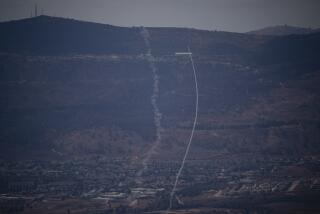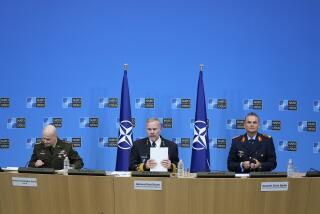NATO Broadens Its Battle Strategy
- Share via
WASHINGTON — Faced with a continuing Serbian offensive against Kosovo’s ethnic Albanians, NATO officials have broadened the goal of their expected airstrikes on Yugoslavia in a way that may prolong the attacks for days or weeks.
As recently as last week, officials said strikes would be aimed at simply degrading the military capabilities of Yugoslav President Slobodan Milosevic at a time when he was defying international pressure for a peace settlement.
On Tuesday, however, as the Yugoslav army pushed ahead in its drive to wipe out remaining strongholds of Albanian guerrillas, officials said the campaign is now aimed at ending the lethal offensive that, since the weekend, has killed dozens and left thousands homeless.
The strikes’ “primary goal . . . would be to arrest the ability of the Serbs to brutally attack the Kosovar Albanians,” said Pentagon spokesman Kenneth H. Bacon.
This task will require NATO fliers to seek out and destroy smaller concentrations of tanks, armored vehicles, artillery and troops--a process that will involve time and risk.
“It takes time,” a senior Pentagon official acknowledged. “But we’ve got plenty of time. NATO’s been around for 50 years.”
In Brussels earlier this week, German Gen. Klaus Naumann, chairman of NATO’s military committee, acknowledged that while the goal was to swiftly complete any airstrikes, the bombardment could be “long and protracted.”
As diplomatic efforts wound down, NATO officials Tuesday outlined plans for an air campaign of several stages that they hope will inflict such pain that the military and security police will pressure Milosevic to capitulate.
All the strikes will come at night, officials said. The first night of operations will direct a shower of cruise missiles at air defenses in Kosovo and other parts of Yugoslavia, including radar stations and antiaircraft batteries. This opening round is intended to disable the infrastructure that could threaten pilots.
On the second night of operations, “the whole armada would be up there, and every country that’s in this will contribute something,” a top-ranking North Atlantic Treaty Organization official said.
In the next phase, the targets would be expanded to Yugoslav military installations below the 44th parallel, which would embrace all of Kosovo but also half of Serbia.
In a third phase, elimination of military facilities could be extended north of the 44th parallel.
NATO members have not yet authorized this but have been talking about it openly because they are counting on the Yugoslav military to pressure Milosevic.
“It’ll cost several billion dollars to replace what we are targeting. We want the Yugoslav military to realize this is no pinprick we have in mind,” the NATO official said.
Officials said the goal was not gradually escalating pressure, but the kind of quick and powerful blow that would swiftly force the Serbs to approve a deal.
Yet some U.S. military officials and analysts acknowledged that because of the complexity of the mission--and the seeming determination of Serbian forces--the job may take substantially longer.
NATO fliers will be trying to strike a force that includes about 40,000 police and troops in and near a province about the size of Maryland.
Serbian forces are equipped with about 400 tanks, 60 surface-to-air missile batteries, several hundred armored personnel carriers and several hundred artillery pieces.
Anticipating strikes, Serbian forces have begun dispersing throughout the province, officials said, in an apparent effort to make themselves harder to hit.
Much of the province is mountainous, making it easier to hide military equipment. And the terrain is often hidden under cloud cover and fog, which makes it difficult to use laser-guided precision bombs, and which sometimes forces a temporary halt to sorties.
Pentagon officials are comparing the mission to Operation Deliberate Force, the 1995 NATO air campaign that helped bring Serbs to the bargaining table and end the conflict in Bosnia-Herzegovina. That three-week effort was repeatedly shut down because of bad weather.
Retired Air Force Lt. Gen. Thomas McInerney, who was assistant Air Force vice chief of staff, said he believes that even with the Air Force’s precision weapons, the mission would probably take two or three weeks.
NATO’s hopes are riding heavily on the idea that Milosevic and his generals will quickly realize that they are paying too high a price.
Some analysts contend that if the Serbs hunker down, they could hold out for a long time--while remaining capable of overpowering the lightly armed Kosovo Liberation Army. Because of this possibility, some Pentagon officials are privately nervous about the mission.
“They think this is a dangerous mission that has no end in sight,” said Ivo Daalder, a Balkans specialist at the Brookings Institution, a nonpartisan think tank in Washington.
*
Richter reported from Washington and Dahlburg from Brussels.
(BEGIN TEXT OF INFOBOX / INFOGRAPHIC)
A Plan of Attack
* PHASE 1: Cruise missiles launched from the Adriatic take out air-defense facilities in Kosovo and on its border.
* PHASE 2: NATO aircraft from positions around Europe target Serbian forces up to the 44th parallel.
* PHASE 3: Elimination of military facilities is extended into Serbia above the 44th parallel.
Source: NATO headquarters
More to Read
Sign up for Essential California
The most important California stories and recommendations in your inbox every morning.
You may occasionally receive promotional content from the Los Angeles Times.














